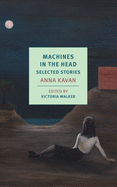
The atmosphere of Anna Kavan's stories is one of anxiety, dread and desperation. Written between 1940 and 1970, the stories collected in Machines in the Head are both hauntingly relevant and entirely alien. As editor Victoria Walker notes in the book's foreword, the enigmatic nature of the British author's work is perhaps best exemplified by the fact that the author named herself for one of her own fictional characters. What's real is never certain in the landscape of Kavan's stories, which often feature nameless protagonists in vaguely defined but unquestionably desolate circumstances.
One of Kavan's greatest strengths is the way in which she imbues menace into seemingly innocuous things. In "A Bright Green Field," it's the iridescence of a meadow at night that stands in for Kavan's real-life tormenters, which included a life-long heroin addiction and several stints in an asylum. For "Ice Storm," Kavan conjures dread by injecting newspaper headlines warning of terrible weather into the narrative. If Kavan's writing is remarkably consistent in terms of theme and symbols, it varies greatly when it comes to subject and setting. Though her earlier work dabbles in elements of the surreal and fantastical, Kavan's later stories approach true sci-fi territory.
Kavan's most memorable lines are succinct summations of despair: "I would like to lay hold of hope and strangle it once and for all," confesses the narrator in "Our City." This is a sentiment shared by many of Kavan's characters, who sometimes appear to be more akin to shadows than human beings. Dark tales deserve their day too, and with Machines in the Head, it's clear Kavan is one of the greats. --Zack Ruskin, freelance reviewer

